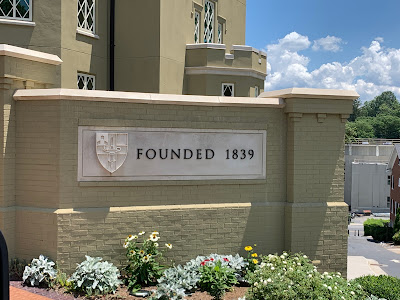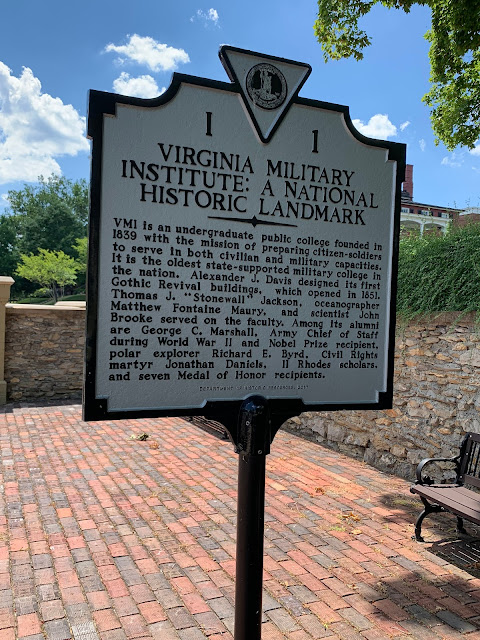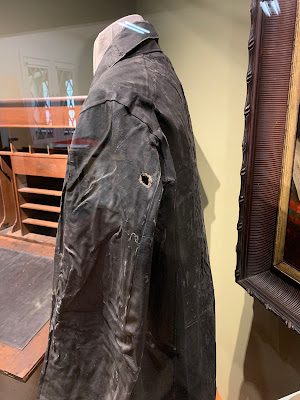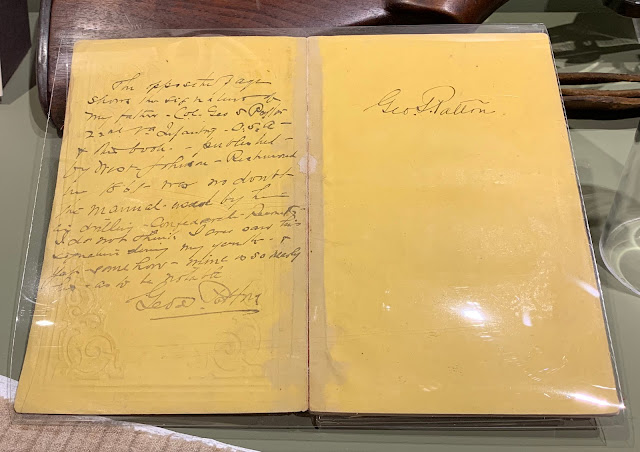Because we like to visit cemeteries and see "famous" graves, we decided to take a drive to Lexington, Virginia to visit the graves of Stonewall Jackson and Robert E. Lee. As we were driving and I was looking at the map for directions (don't worry, Ron was driving) I realized that along with the graves, Stonewall Jackson had a home there. Cool! But imagine our surprise when we pulled off the freeway and saw this.
So we found a parking spot and made our way to the house.
We were pleased to find a docent inside ready to show us around and answer any questions we had. Very few of the items were originals but they had it decorated as it would have been during that time period.
Bedroom
Dining Room
Kitchen
There was one original piece - the desk that Stonewall Jackson used. It was elevated so that he could stand while he worked - he was ahead of his time since now many people work while standing.
Not the original form of elevating it
And then we drove to the cemetery.
And in the middle was Stonewall Jackson.
Remember that Stonewall Jackson lost his left arm when he was shot by friendly fire in Chancellorsville? And then his arm was buried at Ellwood, the home of the owners of Chatham? And here, 100 miles away, is the final burial site of "the rest" of Stonewall Jackson. After his death, Robert E. Lee said: "He has lost his left arm; but I have lost my right arm".
Our next stop was Washington and Lee University
We walked to the University Chapel, formerly Lee Chapel, where Robert E. Lee is buried. The chapel was constructed during 1867-1868 at the request of Robert E. Lee who was president of the school (then known as Washington College) and after whom the university is, in part, named. The Victorian brick architectural design was probably the work of his son, George Washington Custis Lee, with details contributed by Col. Thomas Williamson, an architect and professor of engineering at nearby Virginia Military Institute. Upon completion and during Robert E. Lee's lifetime it was known as the College Chapel and is now a National Historic Landmark. Lee was buried beneath the chapel in 1870.
University Chapel
Uh-oh.
Just our luck the chapel was closed for construction. But Ron would not be deterred and decided to take his life in his hands and maneuver a ledge so he could see in the window.
Or, you can see it here in a photo I borrowed off the internet.
As we walked by this building, we learned that the cadets live in this building during their time there. The Barracks is the focal point of a cadet's life at VMI, and the fact that all cadets are required to live under one roof facilitates student government and helps promote and strengthen ties of friendship. Rooms are furnished sparingly but with essential equipment and three, four, five or even six cadets share a room.
Fortunately, Lee's horse, Traveller (spelled by Lee with two L's in the English tradition), is buried outside so we were able to pay our respects to his very trusted friend. Not long after Lee's death in October, 1870, Traveller stepped on a rusty nail in his stall and died of tetanus. While we'd read that people often leave apples for Traveller, there were none there the day we visited.
And then it was on to the bonus site, Virginia Military Institute (VMI). Founded in 1839, VMI is the oldest state-supported military college in the U.S. Throughout its history, VMI has produced leaders and individuals whose daily lives reflect the integrity, fairness, and appreciation for the value of hard work that is instilled there.
VMI has ranked among the nation's top undergraduate public liberal arts colleges by U.S. News & World Report since 2001. The Institute's effectiveness is demonstrated by generations of VMI graduates. Among the alumni of VMI are a Nobel Prize winner, 11 Rhodes Scholars, seven Medal of Honor recipients, a Pulitzer Prize winner, college presidents, and generals and flag officers.
We parked across the parade grounds in order to visit the museum.
We entered the museum and I found it interesting that one of the first exhibits we saw was this.
And then one of the most amazing collection of guns I've ever seen.
As we talked with one of the museum employees, we related how amazing the collection was and verified that all of the guns were donated by Henry Montgomery. Not only were all of those his private collection, but only half of them were displayed with the rest being in storage.
Once again, Stonewall Jackson artifacts were on display.
His coat from his Union days.
More evidence of the shooting that took his life.
A few other items of interest.
Jackson's desk used in the field
Jackson's saddle
General George Smith Patton Jr. (1885-1945) commanded the Seventh United States Army in the Mediterranean theater of World War II, and the Third United States Army in France and Germany after the Allied invasion of Normandy in June, 1944.
Patton was born in 1885 and attended VMI and the United States Military Academy at West Point. He studied fencing and designed the M1913 Cavalry saber, which was more commonly known as the "Patton Saber". He competed in the pentathlon in the Summer Olympics in Stockholm in 1912.
There were some interesting mentions of the General.
A few years ago we saw the movie Field of Lost Shoes, which is based on the true story of a group of cadets from VMI who participated in the Battle of New Market against Union forces during the Civil War. As we walked through the campus, we were reminded of this movie.
On May 10, 1864, the VMI Corps of Cadets was ordered to join Gen. John C. Breckinridge's Confederate forces near Staunton, Virginia. After marching nearly 85 miles northward, the Corps arrived at New Market on the morning of May 15, 1864. The Union troops, positioned atop Bushong's Hill, raked the Confederate line with cannon and musketry creating a gap in the line. Remarkably, the cadets helped close the gap, allowing the Confederate forces to regroup and push back the Union army which secured the battlefield for the Confederacy. Many cadets lost their footwear in the freshly plowed soil which had turned to mud after several days of rain. That section of the battlefield became known as the "Field of Lost Shoes".
The 257 cadets were organized into a battalion of four companies of Infantry and one section of Artillery. Ten cadets were killed in battle or died later from the effects of their wounds and 45 were wounded. The youngest participating cadet was fifteen; the oldest was twenty-five.
What a great, unexpected day of exploration.








































Love seeing the life of the cadets. The VMI museum is thrilling.
ReplyDeleteWe were so surprised to find it but so glad we did.
Delete